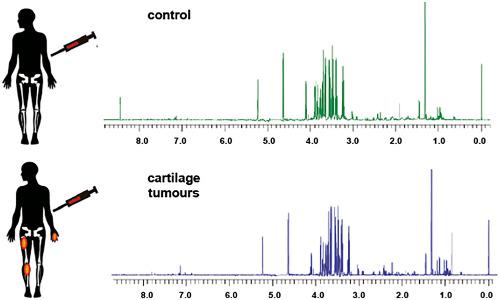当前位置:
X-MOL 学术
›
Magn. Reson. Chem.
›
论文详情
Our official English website, www.x-mol.net, welcomes your
feedback! (Note: you will need to create a separate account there.)
Metabolic profiling of serum in patients with cartilage tumours using 1 H-NMR spectroscopy: a pilot study
Magnetic Resonance in Chemistry ( IF 1.9 ) Pub Date : 2019-07-19 , DOI: 10.1002/mrc.4925 Liliana López-Garrido 1 , Angel E Bañuelos-Hernández 2 , Elizabeth Pérez-Hernández 3 , Romeo Tecualt-Gómez 3 , Jorge Quiroz-Williams 3 , Armando Ariza-Castolo 4 , Elvia Becerra-Martínez 5 , Nury Pérez-Hernández 1
Magnetic Resonance in Chemistry ( IF 1.9 ) Pub Date : 2019-07-19 , DOI: 10.1002/mrc.4925 Liliana López-Garrido 1 , Angel E Bañuelos-Hernández 2 , Elizabeth Pérez-Hernández 3 , Romeo Tecualt-Gómez 3 , Jorge Quiroz-Williams 3 , Armando Ariza-Castolo 4 , Elvia Becerra-Martínez 5 , Nury Pérez-Hernández 1
Affiliation

|
Cartilage‐forming lesions include tumours that can vary in severity from benign enchondromas to high‐grade malignant chondrosarcomas. Chondrosarcoma is the second most frequent malignant bone tumour, accounting for 20–30% of all malignant bone neoplasms. Surgery is the standard treatment for cartilage tumours (CTs); however, their incidental diagnosis and the difficult differentiation of low‐grade lesions like chondrosarcoma grade I from benign entities like enchondroma are challenges for clinical management. In this sense, the search for circulating biomarkers for early detection and prognosis is an ongoing interest. Targeted metabolomics is a powerful tool that can propose potential biomarkers in biological fluids as well as help to discover disturbed metabolic pathways to reveal tumour pathogenesis. In this context, the aim of this study was to investigate the 1H nuclear magnetic resonance metabolomic serum profile of patients with CTs contrasted with healthy controls. Forty‐one metabolites were identified and quantified; the multivariate statistical methods principal component analysis and partial least squares discriminant analysis reveal a clear separation of the CT group, that is, the differential metabolites that were involved in two main metabolic pathways: the taurine and hypotaurine metabolism and synthesis and degradation of ketone bodies. Our results represent preliminary work for emergent serum‐based diagnostics or prognostic methods for patients with chondrogenic tumours.
中文翻译:

使用 1 H-NMR 光谱对软骨肿瘤患者血清进行代谢分析:一项初步研究
软骨形成病变包括严重程度不同的肿瘤,从良性软骨瘤到高级别恶性软骨肉瘤。软骨肉瘤是第二常见的恶性骨肿瘤,占所有恶性骨肿瘤的 20-30%。手术是软骨肿瘤 (CT) 的标准治疗方法;然而,它们的偶然诊断以及低级别病变(如 I 级软骨肉瘤)与良性实体(如软骨瘤)的难区分是临床管理的挑战。从这个意义上说,寻找用于早期检测和预后的循环生物标志物是一个持续的兴趣。靶向代谢组学是一种强大的工具,可以在生物体液中提出潜在的生物标志物,并有助于发现紊乱的代谢途径以揭示肿瘤发病机制。在这种情况下,本研究的目的是调查 CT 患者与健康对照者的 1H 核磁共振代谢组学血清特征。鉴定并定量了 41 种代谢物;多元统计方法主成分分析和偏最小二乘判别分析揭示了CT组的明显分离,即参与两个主要代谢途径的差异代谢物:牛磺酸和亚牛磺酸代谢以及酮体的合成和降解。我们的结果代表了针对软骨源性肿瘤患者的紧急血清诊断或预后方法的初步工作。鉴定并定量了 41 种代谢物;多元统计方法主成分分析和偏最小二乘判别分析揭示了CT组的明显分离,即参与两个主要代谢途径的差异代谢物:牛磺酸和亚牛磺酸代谢以及酮体的合成和降解。我们的结果代表了针对软骨源性肿瘤患者的紧急血清诊断或预后方法的初步工作。鉴定并定量了 41 种代谢物;多元统计方法主成分分析和偏最小二乘判别分析揭示了CT组的明显分离,即参与两个主要代谢途径的差异代谢物:牛磺酸和亚牛磺酸代谢以及酮体的合成和降解。我们的结果代表了针对软骨源性肿瘤患者的紧急血清诊断或预后方法的初步工作。
更新日期:2019-07-19
中文翻译:

使用 1 H-NMR 光谱对软骨肿瘤患者血清进行代谢分析:一项初步研究
软骨形成病变包括严重程度不同的肿瘤,从良性软骨瘤到高级别恶性软骨肉瘤。软骨肉瘤是第二常见的恶性骨肿瘤,占所有恶性骨肿瘤的 20-30%。手术是软骨肿瘤 (CT) 的标准治疗方法;然而,它们的偶然诊断以及低级别病变(如 I 级软骨肉瘤)与良性实体(如软骨瘤)的难区分是临床管理的挑战。从这个意义上说,寻找用于早期检测和预后的循环生物标志物是一个持续的兴趣。靶向代谢组学是一种强大的工具,可以在生物体液中提出潜在的生物标志物,并有助于发现紊乱的代谢途径以揭示肿瘤发病机制。在这种情况下,本研究的目的是调查 CT 患者与健康对照者的 1H 核磁共振代谢组学血清特征。鉴定并定量了 41 种代谢物;多元统计方法主成分分析和偏最小二乘判别分析揭示了CT组的明显分离,即参与两个主要代谢途径的差异代谢物:牛磺酸和亚牛磺酸代谢以及酮体的合成和降解。我们的结果代表了针对软骨源性肿瘤患者的紧急血清诊断或预后方法的初步工作。鉴定并定量了 41 种代谢物;多元统计方法主成分分析和偏最小二乘判别分析揭示了CT组的明显分离,即参与两个主要代谢途径的差异代谢物:牛磺酸和亚牛磺酸代谢以及酮体的合成和降解。我们的结果代表了针对软骨源性肿瘤患者的紧急血清诊断或预后方法的初步工作。鉴定并定量了 41 种代谢物;多元统计方法主成分分析和偏最小二乘判别分析揭示了CT组的明显分离,即参与两个主要代谢途径的差异代谢物:牛磺酸和亚牛磺酸代谢以及酮体的合成和降解。我们的结果代表了针对软骨源性肿瘤患者的紧急血清诊断或预后方法的初步工作。











































 京公网安备 11010802027423号
京公网安备 11010802027423号